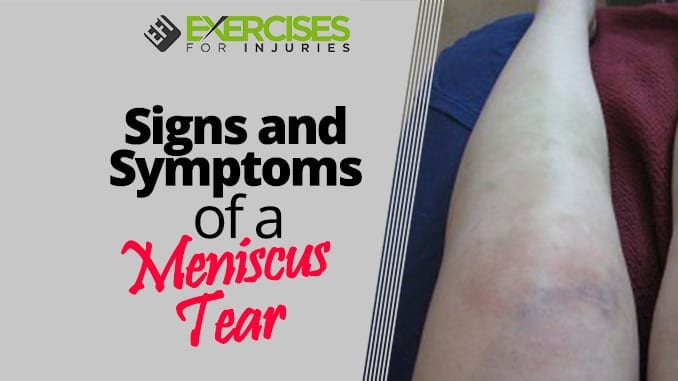
The meniscus is the crescent-shaped cartilage in the knee joint that helps with stability and movement. A meniscus tear can occur when there is a rip or partial tear of this knee joint component. If you have torn your meniscus, you know the pain can be almost unbearable. People can damage the meniscus as they age, participate in strenuous activities, or have anatomical variations like being bowlegged or having an ACL graft. The sooner you identify the signs and symptoms of a meniscus tear, the sooner you can get treatment to help prevent more severe long-term consequences such as osteoarthritis. This is the third article on the topic of meniscus tears. If you missed the last two, you could check them out at the end of this article.
Signs and Symptoms of a Meniscus Tear
The doctor may observe and note swelling, redness, warmth, pain, and function loss during a physical examination for a meniscus injury, just as for other knee injuries.
A client with a meniscal tear may experience and report the following signs and symptoms:
-
Pain
An acute injury to the knee joint line often results in pain after trauma. Meniscal tears can occur without prior trauma. Patients may not remember the damage or even describe the event. For non-traumatic cases, the pain may be intermittent and limited to the affected knee.
-
Tenderness on The Joint Line
According to Baker (2011), 77 to 86% of patients diagnosed with meniscal tears exhibit this symptom, making it an accurate clinical sign of meniscal injuries.
-
Joint Swelling
Some patients may experience swelling in the involved joint line, a delayed symptom. However, others may not exhibit this symptom at all. 50% of patients with meniscus tears (Baker, 2011) presented with knee joint swelling.
Significant swelling that occurs soon after an acute injury is highly suggestive of a meniscus tear resulting from a hemorrhage in the joint space, a condition where bleeding occurs.
A meniscal tear in the outer third of the meniscus is usually associated with immediate swelling and bleeding (Bhagia, 2012). In a 1993 study by Stanitski et al., 47% of patients with hemarthrosis had ACL tears (Bhagia, 2012). Similarly, Bhagia (2012) found that 47% of individuals had meniscal injuries.
-
Locking of the Knee
Locking is a frequent symptom of meniscal tears. A displaced tear is more likely to cause locking within the knee joint. Swelling may mimic the sign of locking. The physician may observe for clicks or snaps after unlocking the joint to distinguish locking from joint swelling.
-
Giving Away Sensation in the Knee
This symptom occurs when the joint lodges a detached fragment. Patients may feel wobbly without warning if a piece is temporarily lodged in the joint. Giving away sensation in the knee may occur immediately or 2 to 3 days after the inciting injury.
-
Abnormal Range of Motion of the Knee
A client with a meniscal injury may experience discomfort while straightening their knee. The client may be unable to complete or perform the movement due to severe pain. When the knee is fully bent, as in squatting, pain may be shared. During walking, compensatory patterns and deviations are also observed.
Diagnosing Meniscal Injuries
A meniscal injury can be accurately diagnosed through a detailed subjective history, physical examination, performance of certain maneuvers, and diagnostic tests.
Taking the History of Your Meniscus Injury
Your doctor will first obtain a thorough history, seeking information about how the injury occurred. In some cases, you may not remember or be able to describe the symptoms that led to the injury. Although trauma does not always cause meniscal tears, a detailed account of the damage is helpful.
Physical Meniscus Injury Examination
Your physician will perform a complete physical examination. During the evaluation, we will assess the joint line tenderness, swelling, and range of motion of the affected knee and the affected leg’s lower spine, hip, and thigh.
Certain provocative maneuvers during a physical examination can diagnose a meniscus injury. By causing impingement of the torn meniscus, these maneuvers elicit the signs and symptoms of a meniscus injury.
Your physician may perform the following provocative maneuvers:
- McMurray Test – A click or knee pain can be elicited by this maneuver when a tear is present.
- Steinmann Test – When the client sits and has their knee bent to 90 degrees, rotating the shin bone produces pain. If the client complains of pain as the shin bone is turned away from the center of the body, a damaged medial meniscus is suspected.
- Apley Test – An individual may have a positive diagnostic test when pain is produced at the medial or lateral aspect of the knee joint as force is applied through the heel with the leg positioned internally or externally rotated.
Diagnostic tests for a Meniscus Tear
The doctor conducts a magnetic resonance imaging (MRI) test to verify the condition. MRI is the definitive imaging study for detecting meniscus problems (Baker, 2011). MRI is better at capturing sharp and clear pictures of the soft tissues in the knee joint than other imaging techniques (Baker, 2011).
Arthroscopy can provide an accurate meniscal tear detection is performed by an experienced arthroscopist (Baker, 2011). According to Baker (2011), arthroscopy is nearly 100% accurate and sensitive in diagnosing meniscal injuries.
Types of Meniscus Tears
It’s vital to know the specific kind of meniscus tear through MRI scanning during the diagnosis. Your treatment plan will also vary depending on the type of injury you’ve sustained.
-
Frayed Tear
A meniscus with frayed and jagged fronds on its sharp edges may indicate degeneration. If you damage the inner meniscal rim, you are unlikely to experience further injuries or complications. A meniscus with frayed fronds across the entire surface may collapse in a ragged fashion. Severe degeneration impairs the meniscus’ shock-absorbing function. Arthritis of the knee is a common condition as a result.
-
Radial Tear
In a radial tear, tearing occurs across the lateral rim of the meniscus. Tearing occurs from the edge of the meniscus, going inwards. In this type, the inner part of the meniscus may not completely heal due to an inadequate supply of blood.
-
Parrot-Beak Tear
If an oblique radial tear is left untreated, it can cause a parrot-beak tear. The incision may assume a rounded beak-shaped appearance as an oblique radial heals.
-
Circumferential Tear
In this type, the tear may run along the cartilage length.
-
Bucket-Handle Tear
A tear running across the length of the meniscus may cause detachment of one of its sections from the shin bone, leading to the formation of a flap that resembles a bucket handle. This type of tear is more susceptible to sustaining more damage. A bucket-handle tear is more likely to cause complete straightening of the knee, locking, and pain.
-
Horizontal Cleavage Tear
A horizontal cleavage tear is a rare tear in the meniscus body. This injury usually degenerates after minor damage.
-
Flap Tear
This tear causes symptoms by splitting the meniscus horizontally down the middle. Occasionally, the flap formed as a result may flip over, resulting in meniscal injuries.
A meniscus tear can affect your entire knee joint and cause significant pain, limping, swelling, and tenderness in the knee joint. However, these are signs that you should take them seriously as they will worsen with time. You should consult your physician if you experience knee pain, swelling, or any of the signs listed above.
There you go, the end of part 3.
If you would like to see the exercise program that I use for meniscus tears, you can check it out here:
Rick Kaselj, MS
If you liked the above, you might find these posts helpful:




